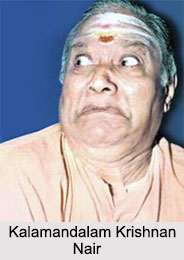 Kalamandalam Krishnan Nair is known as the most versatile Kathakali performer. He is the furthermost Kathakali performer in the history of the four-century-old traditional dance-drama from Kerala in southern India. Krishnan Nair was a legitimate all-rounder who had the quality to emote any role in Kathakali and he added his signature elegance to it. He was widely famous for his act of Nalan, Bhiman, Arjunan, Rukmangadan and Karnan among the people.
Kalamandalam Krishnan Nair is known as the most versatile Kathakali performer. He is the furthermost Kathakali performer in the history of the four-century-old traditional dance-drama from Kerala in southern India. Krishnan Nair was a legitimate all-rounder who had the quality to emote any role in Kathakali and he added his signature elegance to it. He was widely famous for his act of Nalan, Bhiman, Arjunan, Rukmangadan and Karnan among the people.
Early life of Kalamandalam Krishnan Nair
He was born in Payyannur, Kannur district in 1914. He started Kathakali at the age of 13 from Chandu Panikkar. Vallathol Menon who was the poet and Kathakali proponent took him at the age of 19, to Kerala Kalamandalam for further training. There, under the strict discipline and experience of gurus like Pattikkantodi Ramunni Menon, Kunchu Kurup, Kavalappara Narayanan Nair, and Mani Madhava Chakiar, he became an expert in all aspects of the art and knowledge of the epics, Puranas, and other scriptures. After completing his training, he joined the Kalamandalam as an assistant teacher in 1940. Owing to his acting ability and rapid fame, the institution became synonymous with his name. Later, he was main teacher of Margi Kathakali Vidyalayam in Thiruvananthapuram and R. L. V. Institute in Thrippunithura, Ernakulam district for many years.
Career of Kalamandalam Krishnan Nair
Krishnan Nair had an inclination for pragmatic portrayal of characters and the situations which made him more popular in the Travancore belt of south Kerala. Actually, his peculiar style had made him a less acknowledged master in central and north Kerala which are the very places that groomed his art in his early days. Krishnan Nair`s controlling style won him the end number of admirers. In his 20s Nair was known as `Putana Krishnan` because of his excellence in bringing out the beauty and fury of the demoness Putana. He had a good height and build, handsome features, wide and expressive eyes, and flexible facial muscles that brought out all the bhavas and rasas. He achieved the `fourfold perfection`. These fourfold functions can be mentioned as elaboration of the verses with postures and expressions according to the interpretations of a scholarly actor; mastery of hand gestures; angika or physical and sattvika or psychological aspects of acting and the perfect harmony of cholliattam i.e. acting to songs and ilakiattam i.e. acting to percussion.
His minute and subtle body movements in roles like Raudra i.e. furious Bhima, Kichaka, Rukmangada, and Nala earned him a reputation. He also directed unusual episodes, such as Sakuntala, Harishchandra-charita i.e. `Harishchandra`s Life`, and Chitrangada. In public life, he made it a point to highlight Kathakali and its artists. He worked to improve their financial status; previously, many of them died penniless or without proper treatment. Till the age of 75, he performed his attractive lecture-demonstrations with aplomb.
Awards of Kalamandalam Krishnan Nair
Kalamandalam Krishnan Nair was a recipient of Padma Shri and Sangeet Natak Akademi awards.
Personal life of Kalamandalam Krishnan Nair
Kalamandalam Krishnan Nair was married to Kalamandalam Kalyanikutty Amma who was his wife. His daughters, Sreedevi Rajan and Kala Vijayan, are professionals in the field of Mohiniyattam and one of their sons, Kalasala Babu, is a famous actor in the Malayalam drama and movie world. Krishnan Nair`s granddaughter Smitha Rajan is a renowned Mohiniyattam artist.



















